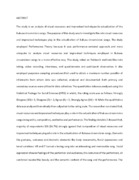| dc.description.abstract | The study is an analysis of visual resources and improvised techniques in actualization of the Bukusu
circumcision songs. The purpose of this study was to investigate the role visual resources and improvised
techniques play in the actualization of Bukusu circumcision songs. The study employed Performance
Theory because it was performance-centered approach and more adequate to analyze visual resources and
improvised techniques employed in Bukusu circumcision songs in a more effective way. The study relied
on fieldwork methods like note taking, video recording, interviews, and questionnaire and participant
observation. It also employed purposive sampling procedures that used to obtain a maximum number
possible of informants from whom data was collected, analyzed and documented. Both primary and
secondary sources were utilized in data collection. The quantitative data was analysed using the Statistical
Package for Social Sciences (SPSS) in which, the rating scale was as follows: Strongly Disagree (SD) =
1; Disagree (D) = 2; Agree (A) = 3; Strongly Agree (SA) = 4. While the qualititative data was analysed
thematically then subjected to the rating scale. The researcher concluded that, visual resources and
improvised techniques play a role in the actualization of Bukusu circumcision songs in regard to;
composition, aesthetics and performance. The findings in table 2 showed that, majority of respondents
106 (56.7%) strongly agreed that composition of visual resources and improvised techniques played a role
in the actualization of Bukusu circumcision songs. Elements like gestures, costumes and dramatic
elements like body movements, facial expressions and tonal variations. VR and IT turned a boring song
into an interesting and memorable song. Facial expression showed feelings of the performer and
audiences, the costumes of the performers, all combined reveled the beauty and the semantic content of
the song and the performance. The findings on aesthetics in table 3 established that, women’s personal
interest in aesthetics in BSC had a role on use of visual resources and improvised techniques, ululation
brought in a happy mood of the mother and aunties of a circumcision candidate at 15 (76.9%). Youth at
20 (66.3%) believed that aesthetics had a role on VR and IT like costumes was associated with seriousness
of the initiation process. Men liked aesthetics of visual resources and improvised techniques at 35 (70.7%).
These implied that, men just like women and youth had an interest in aesthetics exhibited in BCS through
VR and IT made the song exciting. VR and IT in BCSs had its messages as well as its aesthetics which
were learned through the language of drum, the clapping of hands, the characterization and body
movements of the performers; the participation of audience and their imitation of the other audience-performers and the ululations by aunties and mothers made the songs enjoyable. Concerning the
performance of VT and IT, the study in table 4 established that, 113 (60.6%) strongly agreed that, during
performance of BSC, visual resources and improvised techniques were employed by the both the
performer and audience-performer that made a song lively. The study recommends that, the roles of visual
resources and improvised techniques in Bukusu circumcision songs cannot be ignored; there is need for
the government of Kenya and other cultural stakeholders to appreciate these components and initiate
programs that promotes traditional circumcision songs as a sources of tourist attraction activities in Kenya. | en_US |
